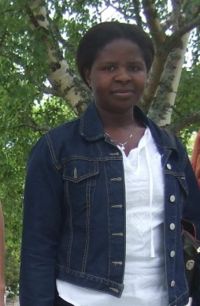Difference between revisions of "User:Allen Asiimwe"
| Line 7: | Line 7: | ||
I am currently teaching (and coordinating) Runyakitara at Makerere University. Runyakitara is the name given to the four closely related dialects i.e. Runyankore, Rukiga, Runyoro, and Rutooro, spoken in the south-western part of Uganda. Since the lexical similarity between Runyankore and Rukiga is almost 100% they are normally referred to as Runyakore-Rukiga, as one language and the same is true for Runyoro and Rutooro. My dialect is Rukiga and all my research so far is on Runyankore-Rukiga. | I am currently teaching (and coordinating) Runyakitara at Makerere University. Runyakitara is the name given to the four closely related dialects i.e. Runyankore, Rukiga, Runyoro, and Rutooro, spoken in the south-western part of Uganda. Since the lexical similarity between Runyankore and Rukiga is almost 100% they are normally referred to as Runyakore-Rukiga, as one language and the same is true for Runyoro and Rutooro. My dialect is Rukiga and all my research so far is on Runyankore-Rukiga. | ||
| − | About my MPhil thesis titled: Morpho-syntactic Patterns in Runyankore-Rukiga, the approach is descriptive, the main purpose was to document important grammatical constructs in Runyankore-Rukiga. The Introductory Chapter describes in brief the noun and verbal morphology in Runyakore-Rukiga. I investigated Locative Marking in Runyakore-Rukiga, Locative-Inversion in Runyankore-Rukiga; a comparative analysis with other Bantu languages, and to the best of my knowledge, no one has ever done a comprehensive research on locative marking in Runyankore-Rukiga. There is also a chapter on the Grammatical | + | About my MPhil thesis titled: Morpho-syntactic Patterns in Runyankore-Rukiga, the approach is descriptive, the main purpose was to document important grammatical constructs in Runyankore-Rukiga. The Introductory Chapter describes in brief the noun and verbal morphology in Runyakore-Rukiga. I investigated Locative Marking in Runyakore-Rukiga, Locative-Inversion in Runyankore-Rukiga; a comparative analysis with other Bantu languages, and to the best of my knowledge, no one has ever done a comprehensive research on locative marking in Runyankore-Rukiga. There is also a chapter on the Grammatical Functions of the Initial Vowel in Runyakore-Rukiga which is another neglected area, yet it impacts on almost all parts of grammar of Bantu languages . All the illustrations in Runyankore-Rukiga used in my thesis were glossed using Typecraft. |
Together with Dorothee Beermann, my MPhil(Lin) supervisor, I have continued to investigate locative Marking in Runyankore-Rukiga. We are currently looking at the morpho-syntax of locative expressions in Runyankore-Rukiga, focusing mainly on the multi-functional nature of locative classes. | Together with Dorothee Beermann, my MPhil(Lin) supervisor, I have continued to investigate locative Marking in Runyankore-Rukiga. We are currently looking at the morpho-syntax of locative expressions in Runyankore-Rukiga, focusing mainly on the multi-functional nature of locative classes. | ||
I am committed to working and doing more research on my mother tongue, I would like to see it grow. I am also devoted to working with Typcraft. | I am committed to working and doing more research on my mother tongue, I would like to see it grow. I am also devoted to working with Typcraft. | ||
Revision as of 13:47, 15 October 2009
My name is Allen Asiimwe. I am a Ugandan and I live in Uganda. I work at Makerere University in Kampala, in the Institute of Languages as an Assistant Lecturer. I hold a Bachelor of Arts degree and a Postgraduate Diploma in Education both from Makerere University, Kampala Uganda. I also hold a Master of Philosophy (Linguistics) from the Norwegian University of Science and Technology. I am currently teaching (and coordinating) Runyakitara at Makerere University. Runyakitara is the name given to the four closely related dialects i.e. Runyankore, Rukiga, Runyoro, and Rutooro, spoken in the south-western part of Uganda. Since the lexical similarity between Runyankore and Rukiga is almost 100% they are normally referred to as Runyakore-Rukiga, as one language and the same is true for Runyoro and Rutooro. My dialect is Rukiga and all my research so far is on Runyankore-Rukiga.
About my MPhil thesis titled: Morpho-syntactic Patterns in Runyankore-Rukiga, the approach is descriptive, the main purpose was to document important grammatical constructs in Runyankore-Rukiga. The Introductory Chapter describes in brief the noun and verbal morphology in Runyakore-Rukiga. I investigated Locative Marking in Runyakore-Rukiga, Locative-Inversion in Runyankore-Rukiga; a comparative analysis with other Bantu languages, and to the best of my knowledge, no one has ever done a comprehensive research on locative marking in Runyankore-Rukiga. There is also a chapter on the Grammatical Functions of the Initial Vowel in Runyakore-Rukiga which is another neglected area, yet it impacts on almost all parts of grammar of Bantu languages . All the illustrations in Runyankore-Rukiga used in my thesis were glossed using Typecraft.
Together with Dorothee Beermann, my MPhil(Lin) supervisor, I have continued to investigate locative Marking in Runyankore-Rukiga. We are currently looking at the morpho-syntax of locative expressions in Runyankore-Rukiga, focusing mainly on the multi-functional nature of locative classes.
I am committed to working and doing more research on my mother tongue, I would like to see it grow. I am also devoted to working with Typcraft.
